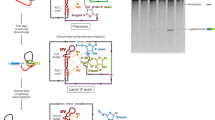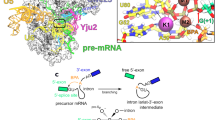Abstract
LAGLIDADG endonucleases bind across adjacent major grooves via a saddle-shaped surface and catalyze DNA cleavage. Some LAGLIDADG proteins, called maturases, facilitate splicing by group I introns, raising the issue of how a DNA-binding protein and an RNA have evolved to function together. In this report, crystallographic analysis shows that the global architecture of the bI3 maturase is unchanged from its DNA-binding homologs; in contrast, the endonuclease active site, dispensable for splicing facilitation, is efficiently compromised by a lysine residue replacing essential catalytic groups. Biochemical experiments show that the maturase binds a peripheral RNA domain 50 Å from the splicing active site, exemplifying long-distance structural communication in a ribonucleoprotein complex. The bI3 maturase nucleic acid recognition saddle interacts at the RNA minor groove; thus, evolution from DNA to RNA function has been mediated by a switch from major to minor groove interaction.
This is a preview of subscription content, access via your institution
Access options
Subscribe to this journal
Receive 12 print issues and online access
$189.00 per year
only $15.75 per issue
Buy this article
- Purchase on Springer Link
- Instant access to full article PDF
Prices may be subject to local taxes which are calculated during checkout








Similar content being viewed by others
References
Cech, T.R. Self splicing of group I introns. Annu. Rev. Biochem. 59, 543–568 (1990).
Michel, F. & Westhof, E. Modelling of the three-dimensional architecture of group I catalytic introns based on comparative sequence analysis. J. Mol. Biol. 216, 585–610 (1990).
Adams, P.L., Stahley, M.R., Kosek, A.B., Wang, J. & Strobel, S.A. Crystal structure of a self-splicing group I intron with both exons. Nature 430, 45–50 (2004).
Golden, B.L., Kim, H. & Chase, E. Crystal structure of a phage Twort group I ribozyme-product complex. Nat. Struct. Mol. Biol. 12, 82–89 (2004).
Weeks, K.M. Protein-facilitated RNA folding. Curr. Opin. Struct. Biol. 7, 336–342 (1997).
Hur, M., Geese, W.J. & Waring, R.B. Self-splicing activity of the mitochondrial group-I introns from Aspergillus nidulans and related introns from other species. Curr. Genet. 32, 399–407 (1997).
Bassi, G.S., de Oliveira, D.M., White, M.F. & Weeks, K.M. Recruitment of intron-encoded and co-opted proteins in splicing of the bI3 group I intron RNA. Proc. Natl. Acad. Sci. USA 99, 128–133 (2002).
Lambowitz, A.M., Caprara, M.G., Zimmerly, S. & Perlman, P.S. Group I and Group II ribozymes as RNPs: clues to the past and guides to the future. in The RNA World (eds. Gesteland, R.F., Cech, T.R. & Atkins, J.F.) 451–485 (Cold Spring Harbor Laboratory Press, Cold Spring Harbor, NY, 1999).
Rho, S.B. & Martinis, S.A. The bI4 group I intron binds directly to both its protein splicing partners, a tRNA synthetase and maturase, to facilitate RNA splicing activity. RNA 6, 1882–1894 (2000).
Lazowska, J., Jacq, C. & Slonimski, P.P. Sequence of introns and flanking exons in wild-type and box3 mutants of cytochrome b reveals an interlaced splicing protein coded by an intron. Cell 22, 333–348 (1980).
Szczepanek, T. & Lazowska, J. Replacement of two non-adjacent amino acids in the S. cerevisiae bi2 intron-encoded RNA maturase is sufficient to gain a homing-endonuclease activity. EMBO J. 15, 3758–3767 (1996).
Ho, Y., Kim, S.J. & Waring, R.B. A protein encoded by a group I intron in Aspergillus nidulans directly assists RNA splicing and is a DNA endonuclease. Proc. Natl. Acad. Sci. USA 94, 8994–8999 (1997).
Gampel, A. & Tzagoloff, A. In vitro splicing of the terminal intervening sequence of Saccharomyces cerevisiae cytochrome b pre-mRNA. Mol. Cell. Biol. 7, 2545–2551 (1987).
Weeks, K.M. & Cech, T.R. Efficient protein-facilitated splicing of the yeast mitochondrial bI5 intron. Biochemistry 34, 7728–7738 (1995).
Bolduc, J.M. et al. Structural and biochemical analyses of DNA and RNA binding by a bifunctional homing endonuclease and group I intron splicing factor. Genes Dev. 17, 2875–2888 (2003).
Paukstelis, P.J. et al. A tyrosyl-tRNA synthetase adapted to function in group I intron splicing by acquiring a new RNA binding surface. Mol. Cell 17, 417–428 (2005).
Dalgaard, J. et al. Statistical modeling and analysis of the LAGLIDADG family of site-specific endonucleases and identification of an intein that encodes a site-specific endonuclease of the HNH family. Nucleic Acids Res. 25, 4626–4638 (1997).
Chevalier, B.S. & Stoddard, B.L. Homing endonucleases: structural and functional insight into the catalysis of intron/intein mobility. Nucleic Acids Res. 29, 3757–3774 (2001).
Belfort, M. Two for the price of one: a bifunctional intron-encoded DNA endonuclease-RNA maturase. Genes Dev. 17, 2860–2863 (2003).
Bassi, G.S. & Weeks, K.M. Kinetic and thermodynamic framework for assembly of the six-component bI3 group I intron ribonucleoprotein catalyst. Biochemistry 42, 9980–9988 (2003).
Lazowska, J. et al. Protein encoded by the third intron of cytochrome b gene in Saccharomyces cerevisiae is an mRNA maturase. Analysis of mitochondrial mutants, RNA transcripts proteins and evolutionary relationships. J. Mol. Biol. 205, 275–289 (1989).
Galburt, E.A. & Stoddard, B.L. Catalytic mechanisms of restriction and homing endonucleases. Biochemistry 41, 13851–13860 (2002).
Silva, G.H., Dalgaard, J.Z., Belfort, M. & Van Roey, P. Crystal structure of the thermostable archaeal intron-encoded endonuclease I-DmoI. J. Mol. Biol. 286, 1123–1136 (1999).
Heath, P.J., Stephens, K.M., Monnat, R.J.J. & Stoddard, B.L. The structure of I–Crel, a group I intron-encoded homing endonuclease. Nat. Struct. Biol. 4, 468–476 (1997).
Chevalier, B.S., Monnat, R.J.J. & Stoddard, B.L. The homing endonuclease I–CreI used three metals, one of which is shared between the two active sites. Nat. Struct. Biol. 8, 312–316 (2001).
Chatterjee, P., Brady, K.L., Solem, A., Ho, Y. & Caprara, M.G. Functionally distinct nucleic acid binding sites for a group I intron encoded RNA maturase/DNA homing endonuclease. J. Mol. Biol. 329, 239–251 (2003).
Goddard, M.R. & Burt, A. Recurrent invasion and extinction of a selfish gene. Proc. Natl. Acad. Sci. USA 96, 13880–13885 (1999).
Chevalier, B. et al. Metal-dependent DNA cleavage mechanism of the I–CreI LAGLIDADG homing endonuclease. Biochemistry 43, 14015–14026 (2004).
Seligman, L.M. et al. Mutations altering the cleavage specificity of a homing endonuclease. Nucleic Acids Res. 30, 3870–3879 (2002).
Latham, J.A. & Cech, T.R. Defining the inside and outside of a catalytic RNA molecule. Science 245, 276–282 (1989).
Das, R., Laederach, A., Pearlman, S.M., Herschlag, D. & Altman, R.B. SAFA: Semi-automated footprinting analysis software for high-throughput quantification of nucleic acid footprinting experiments. RNA 11, 344–354 (2005).
Murphy, F.L. & Cech, T.R. GAAA tetraloop and conserved bulge stabilize tertiary structure of a group I intron domain. J. Mol. Biol. 236, 49–63 (1994).
Cate, J.H. et al. Crystal structure of a group I ribozyme domain: principles of RNA packing. Science 273, 1678–1685 (1996).
Culver, G.M. & Noller, H.F. Directed hydroxyl radical probing of RNA from iron(II) tethered to proteins in ribonucleoprotein complexes. Methods Enzymol. 318, 461–475 (2000).
Ryder, S.P., Ortoleva-Donnelly, L., Kosek, A.B. & Strobel, S.A. Chemical probing of RNA by nucleotide analog interference mapping. Methods Enzymol. 317, 92–109 (2000).
Weeks, K.M. & Crothers, D.M. Major groove accessibility of RNA. Science 261, 1574–1577 (1993).
Draper, D.E. Themes in RNA-protein recognition. J. Mol. Biol. 293, 255–270 (1999).
Huang, D.B. et al. Crystal structure of NF-κB (p50)2 complexed to a high-affinity RNA aptamer. Proc. Natl. Acad. Sci. USA 100, 9268–9273 (2003).
Nolte, R.T., Conlin, R.M., Harrison, S.C. & Brown, R.S. Differing roles for zinc fingers in DNA recognition: structure of a six-finger transcription factor IIIA complex. Proc. Natl. Acad. Sci. USA 95, 2938–2943 (1998).
Lu, D., Searles, M.A. & Klug, A. Crystal structure of a zinc-finger-RNA complex reveals two modes of molecular recognition. Nature 426, 96–100 (2003).
Downing, M.E., Brady, K.L. & Caprara, M.G. A C-terminal fragment of an intron-encoded maturase is sufficient for promoting group I intron splicing. RNA 11, 437–446 (2005).
Otwinowski, Z. & Minor, W. Processing of X-ray diffraction data collected in oscillation mode. Methods Enzymol. 276, 307–326 (1997).
Brunger, A.T. et al. Crystallography and NMR system (CNS): A new software system for macromolecular structure determination. Acta Crystallogr. D Biol. Crystallogr. 54, 905–921 (1998).
Collaborative Computational Project. Number 4 The CCP4 suite: programs for protein crystallography. Acta Crystallogr. D Biol. Crystallogr. 50, 760–763 (1994).
Ramakrishnan, V. & Biou, V. Treatment of multiwavelength anomalous diffraction data as a special case of multiple isomorphous replacement. Methods Enzymol. 276, 538–557 (1997).
Jones, T.A., Zou, J.Y., Cowan, S.W. & Kjeldgaard, M. Improved methods for building protein models in electron density maps and location of errors in these models. Acta Crystallogr. D Biol. Crystallogr. 47, 110–119 (1991).
McRee, D.E. XtalView/Xfit - A versatile program for manipulating atomic coordinates and electron density. J. Struct. Biol. 125, 156–165 (1999).
Lovell, S.C. et al. Structure validation by C-alpha geometry: phi, psi, and C-beta deviation. Proteins 50, 437–450 (2003).
Kleywegt, G.J. & Jones, T.A. Detecting folding motifs and similarities in protein structures. Methods Enzymol. 277, 525–545 (1997).
Acknowledgements
We are indebted to L. Pedersen and Z. Dauter for assistance with synchrotron data collection at beamline X9B at Brookhaven National Laboratory, D. de Oliveira for performing DNA binding assays and our colleagues for critical comments on the manuscript. This work was supported by the US National Institutes of Health (NIH) grant GM56222 to K.M.W. and by the Intramural Research Program of the NIH, National Institute of Environmental Health Sciences (T.M.T.H.).
Author information
Authors and Affiliations
Corresponding authors
Ethics declarations
Competing interests
The authors declare no competing financial interests.
Supplementary information
Supplementary Fig. 1
2′-O-methyl interference analysis of the bI3 maturase-RNA interaction. (PDF 150 kb)
Supplementary Fig. 2
bI3 maturase-facilitated splicing of the AnCOB group I intron RNA in the cytochrome b gene of Aspergillus nidulans. (PDF 172 kb)
Rights and permissions
About this article
Cite this article
Longo, A., Leonard, C., Bassi, G. et al. Evolution from DNA to RNA recognition by the bI3 LAGLIDADG maturase. Nat Struct Mol Biol 12, 779–787 (2005). https://doi.org/10.1038/nsmb976
Received:
Accepted:
Published:
Issue Date:
DOI: https://doi.org/10.1038/nsmb976
This article is cited by
-
RNA editing restores critical domains of a group I intron in fern mitochondria
Current Genetics (2011)
-
Evolutionary Dynamics of the mS952 Intron: A Novel Mitochondrial Group II Intron Encoding a LAGLIDADG Homing Endonuclease Gene
Journal of Molecular Evolution (2011)



